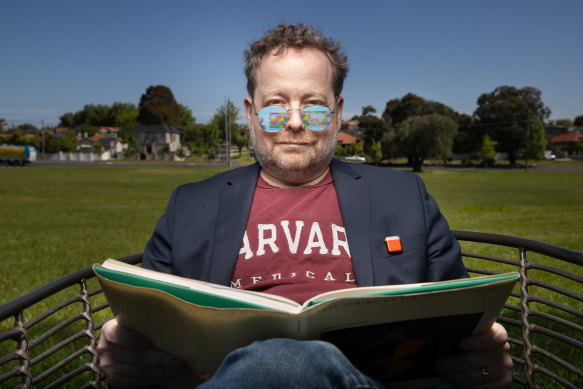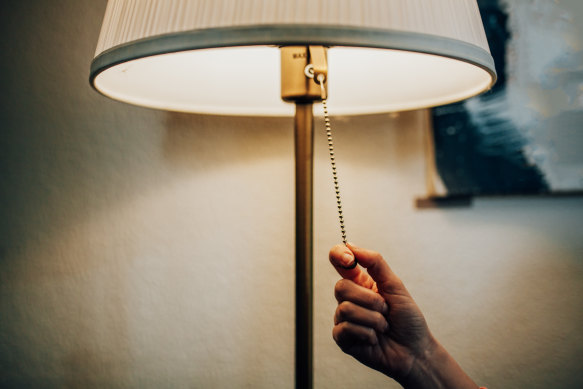This was published 7 months ago
Light exposure can alter your lifespan by up to five years
By Sarah Berry
In the not too distant future, Professor Sean Cain imagines we will think of the way we light our homes at night the same way we think of parents who used to smoke in cars with children in the back seat.
“In another 10 years, we’ll look back, and think, ‘Wow, what were we doing to ourselves?’ ” says Cain, who has been studying the effects of light on our circadian system and the flow-on effects to cognitive, mental and physical health since the 1990s.

We need to see the light if we want to live longer, says Professor Sean Cain.Credit: Simon Schluter
His latest study, published in the Proceedings of the National Academy of Sciences, involved providing more than 88,000 adults over the age of 40 with wearable light sensors for one week and following up on their outcomes more than eight years later.
Cain found that poor light patterns – bright light at night and dim light during the day – increased the risk of premature death by 30 per cent.
“People with the best light exposure patterns lived about five years longer than the people with poor light exposure patterns,” adds Cain, who led the research alongside his colleagues at Flinders University, Dr Andrew Phillips and Dan Windred.
Though they adjusted for factors such as age, sex, socioeconomic status and sleep duration, it is difficult to fully tease out what is driving the effects, says Associate Professor Nat Marshall, who specialises in sleep and sleep disorders at The Woolcock Institute of Medical Research and Macquarie University.
Still, Marshall says, it’s a “very impressive” study.
“We have evolved in a 24-hour light/dark cycle and that’s baked into the DNA of most living creatures including ourselves,” he adds.
The study builds upon previous research findings that poor light behaviour increases the risk of type 2 diabetes by 30 to 40 per cent, while greater exposure to daytime light seems to have a protective effect on our mental health and is associated with a lower risk of depression, anxiety and other disorders.
Light sets the time on our circadian clock. When our biological and behavioural rhythms are out of alignment, our systems are more prone to malfunction.
For instance, our body doesn’t process food as well late at night, when our body is trying to wind down.
“So you’ll tend to gain weight more and have probably more difficulty in processing glucose and whatnot at night,” Cain explains.
He adds that the pancreas, gut and liver are all rhythmic as well, operating differently depending on the time of day. “When you disrupt the clocks with low daytime light and high nighttime light, it’s going to lead to more disruptions in this tissue’s ability to do its job at the right time.”
The result is a greater propensity towards illness. “Poor light patterns will tend to make you more vulnerable to whatever chronic disease you might tend toward.”

Lighting up our lives, at the right times of day, is vitally important.Credit: Getty Images/iStockphoto
This is particularly problematic for Australia’s 1.4 million shift workers.
“Unfortunately, there’s no magic bullet here,” Cain admits. “We are day-active, night-sleeping animals, and when we don’t do that, we’re acting against our physiology.”
Though people in certain professions may not be able to choose when they are and are not exposed to light, Marshall agrees that, in the long term, poor light patterns can negatively affect health.
And though blue light is perceived differently in our brain and may suppress melatonin, Marshall says this research suggests the intensity of the light is more important than the hue.
Interestingly, chronotype (our inclination to sleep and wake at certain times) does little to influence the effect of bright light at night.
Previous research has found that when electric lights are removed at night (while camping, for instance), night owls tend to adopt similar sleep and wake behaviours to those who consider themselves early birds.
“The power of your chronotype really is more of a modern phenomenon that is a result of exposure to artificial light,” says Cain, who has developed a wearable light sensor which will soon become available to the public.
In the future, he anticipates that we will become more cognisant of the health effects of bright lights at night and switch to smart lights, which automatically dim and emit a more orange light.
The good news is that our bodies are highly responsive to changes in light.
When we start exposing ourselves to healthier light patterns – bright, natural light upon waking and throughout the day (natural daylight is far more intense than artificial office lights), dimmer lights as the sun goes down and near total darkness for sleeping – the strength of our clocks are boosted quickly.
“They’re better able to influence and control all of your physiology essentially,” Cain says. “Your clock can better organise all of your body to be doing the right things at the right time.”
Make the most of your health, relationships, fitness and nutrition with our Live Well newsletter. Get it in your inbox every Monday.